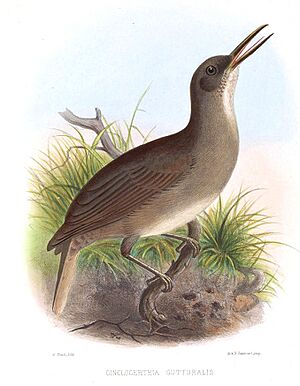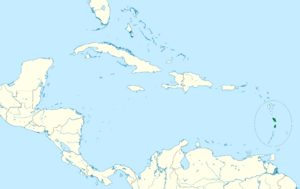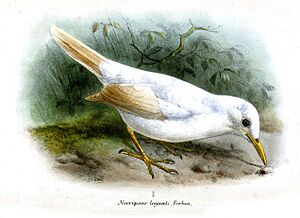Grey trembler facts for kids
Quick facts for kids Grey trembler |
|
|---|---|
 |
|
| 1869 illustration by Joseph Smit | |
| Conservation status | |
| Scientific classification | |
| Genus: |
Cinclocerthia
|
| Species: |
gutturalis
|
 |
|
| Synonyms | |
|
Cinclocerthia macrorhyncha Sclater, 1868 |
|
The grey trembler (Cinclocerthia gutturalis) is a type of songbird found only on the islands of Martinique and Saint Lucia. These islands are in the Lesser Antilles, a group of islands in the Caribbean Sea. It belongs to the Mimidae family, which includes mockingbirds and thrashers. The grey trembler gets its name from a special way it moves its wings.
Contents
About the Grey Trembler's Family Tree
Scientists group living things into families based on how they are related. This is called taxonomy. The grey trembler was once thought to be the same species as its close relative, the brown trembler. The grey trembler has two main types, called subspecies. These are C. g. gutturalis and C. g. macrorhyncha.
The "Mascarene Starling" Mystery
In 1898, a strange bird skin was found at the World Museum Liverpool. People thought it was an extinct starling from Madagascar or the Mascarene Islands. A scientist named Henry Ogg Forbes gave it the name Necropsar leguati. It was even sketched by a bird artist, John Gerrard Keulemans. Some called it the "white Mascarene starling."
However, in 2000, scientists at the Smithsonian Institution studied the bird's DNA. They discovered it was not a new species at all. It was actually a grey trembler with albinism. Albinism is a rare condition that makes an animal's skin and feathers very pale. So, the "Mascarene starling" was just a misidentified grey trembler.
What the Grey Trembler Looks Like
The grey trembler is about 23 to 26 centimeters (9 to 10 inches) long. It weighs between 65 and 76.2 grams (2.3 to 2.7 ounces). This bird has a long beak that curves slightly downwards. Female grey tremblers have longer beaks than males.
Adult birds of the main subspecies have warm gray-brown feathers on their upper body. Their face and wings are a bit darker. Their throat and the middle of their chest are a buffy white color. The sides of their chest are lighter gray-brown, and their sides are browner with a hint of olive green. Young grey tremblers are browner and have a spotted chest. The other subspecies, C. g. macrorhyncha, has a grayer chest and pale cinnamon-colored sides.
Where Grey Tremblers Live
The C. g. gutturalis subspecies lives only on the island of Martinique. The C. g. macrorhyncha subspecies is found only on Saint Lucia. Both types of grey tremblers mostly live in wet, old forests. However, you can also find them in drier scrub areas and open woodlands.
Grey Trembler Behavior
Grey tremblers are named for a special way they move. They often drop their wings slightly away from their body. Then, they make very fast up-and-down and side-to-side movements. This is their unique "trembling" behavior.
How Grey Tremblers Find Food
The grey trembler looks for food from the ground all the way up to the tops of the trees. It tears open tangled plants and pokes into clusters of epiphytes. Epiphytes are plants that grow on other plants. Scientists have not studied their diet in great detail. But they know grey tremblers eat insects and other small creatures without backbones. They also eat fruits and sometimes small lizards.
Grey Trembler Reproduction
Grey tremblers usually breed in March and April. Scientists have found two types of nests. One is an open cup made from thin twigs and dead leaves. The other is a dome-shaped nest made of dried grass. A female grey trembler usually lays two or three eggs at a time.
The Grey Trembler's Song
The song of the grey trembler is made of repeated notes and phrases. It can sound harsh or like a melodic, wavering whistle.
Conservation Status
The IUCN (International Union for Conservation of Nature) has listed the grey trembler as a species of Least Concern. This means that even though it lives on only two islands, it is quite common on both. There are no major threats known to this bird. The only concern is that it lives in a very small area.



